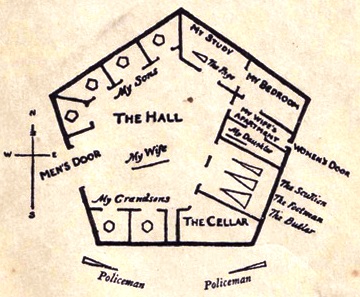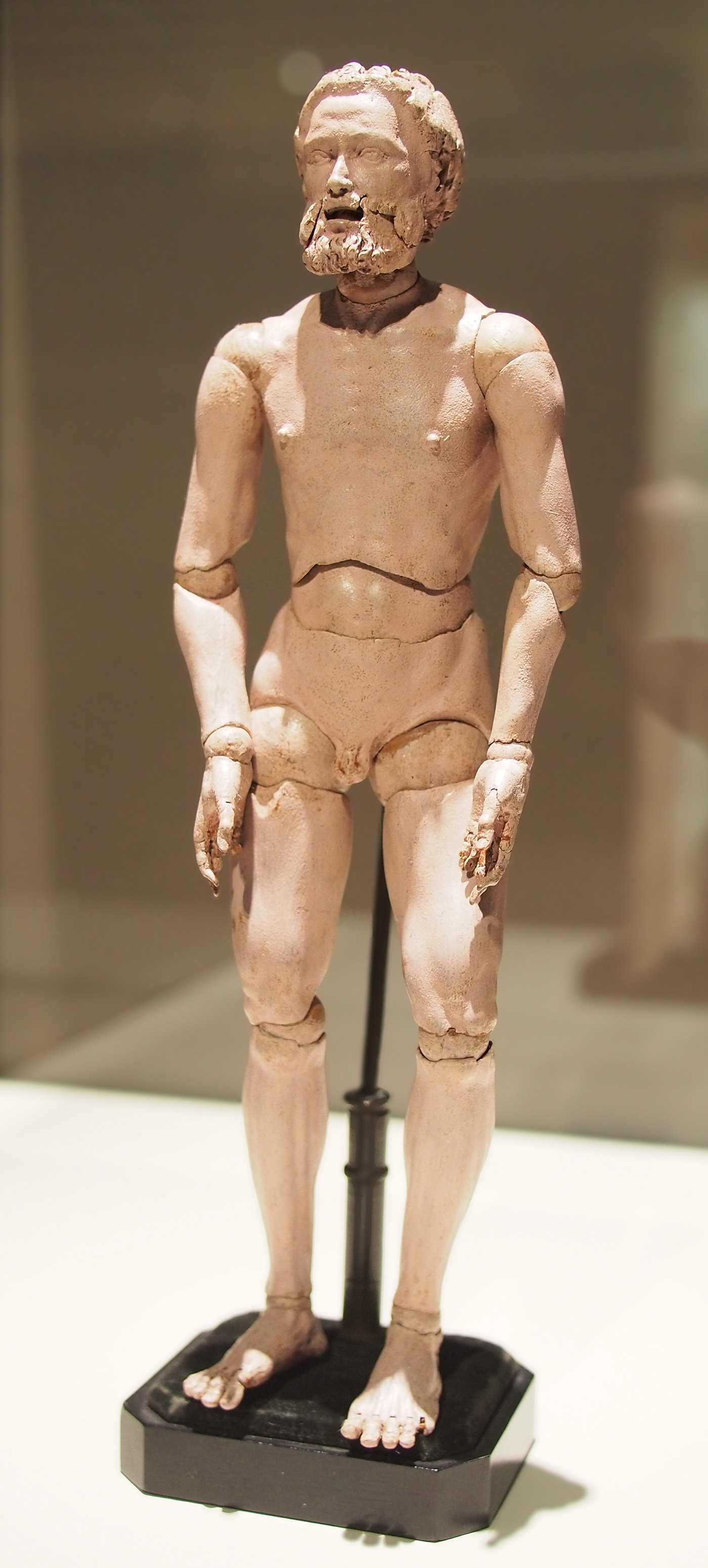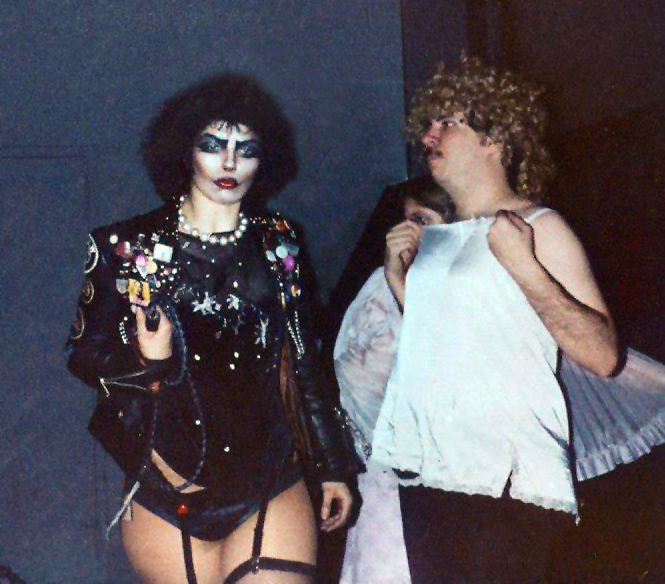|
Frank (comics)
Frank is a cartoon character created by American cartoonist Jim Woodring. Frank is a bipedal, bucktoothed animal of uncertain species whom Woodring described as a "generic anthropomorph". The stories and supporting characters appear in a world called the Unifactor. Overview Frank is a bipedal anthropomorphic animal character of uncertain species—what his creator Jim Woodring describes as a "generic anthropomorph". The surreal, symbolic, and pantomimic stories take place in an idyllic world of mysterious forces called the Unifactor. Woodring describes Frank as "11 years old ... covered with short, dense fur like a mole's ... innocent but not noble ... mortal and must someday die". His pets and protectors Pupshaw and Pushpaw accompany him on his wanderings through the Unifactor, where he encounters colorful, top-shaped jivas, geometrically shaped Jerry Chickens, the diabolic moon-faced Whim, his "Faux Pa" (or "false father"), and the avaricious Manhog. Frank ... [...More Info...] [...Related Items...] OR: [Wikipedia] [Google] [Baidu] |
Frank In The River
''Frank in the River'' is a 24-page comic story by Jim Woodring. Like all Frank stories, ''Frank in the River'' is virtually wordless and the story is conveyed entirely in pantomime. Publication history It was published by Tundra in 1992 in a special full-color issue of '' Tantalizing Stories'', ''Tantalizing Stories Presents Frank in the River'', and features Woodring's signature character, Frank. The special issue also included a shorter full-color story by Mark Martin featuring his character Montgomery Wart. Plot synopsis While trespassing inside an elaborate ornamental garden, Frank accidentally knocks over a huge statue, destroying it and part of a wall. Receiving a bill for the damages, he takes a job cleaning the inside and grounds of a large building which seems to be a palace. While he is cleaning he notices a red cistern in the center of one of the palace rooms. At the end of the day he is fed a meal of gruel by Manhog, who apparently is also a palace employee. The ... [...More Info...] [...Related Items...] OR: [Wikipedia] [Google] [Baidu] |
The Millennium Whole Earth Catalog
The ''Whole Earth Catalog'' (WEC) was an American counterculture magazine and product catalog published by Stewart Brand several times a year between 1968 and 1972, and occasionally thereafter, until 1998. The magazine featured essays and articles, but was primarily focused on product reviews. The editorial focus was on self-sufficiency, ecology, alternative education, " do it yourself" (DIY), and holism, and featured the slogan "access to tools". While WEC listed and reviewed a wide range of products (clothing, books, tools, machines, seeds, etc.), it did not sell any of the products directly. Instead, the vendor's contact information was listed alongside the item and its review. This is why, while not a regularly published periodical, numerous editions and updates were required to keep price and availability information up to date. Steve Jobs compared ''The Whole Earth Catalog'' to Internet search engine Google in his June 2005 Stanford University commencement speech. When ... [...More Info...] [...Related Items...] OR: [Wikipedia] [Google] [Baidu] |
Parallel Universe (fiction)
A parallel universe, also known as a parallel dimension, alternate universe, or alternate reality, is a hypothetical self-contained plane of existence, co-existing with one's own. The sum of all potential parallel universes that constitute reality is often called a "multiverse". While the four terms are generally synonymous and can be used interchangeably in most cases, there is sometimes an additional connotation implied with the term "alternate universe/reality" that implies that the reality is a variant of our own, with some overlap with the similarly named alternate history. Fiction has long borrowed an idea of "another world" from mythology, myth, legend and religion. Heaven, Hell, Twelve Olympians, Olympus, and Valhalla are all "alternative universes" different from the familiar material realm. Plato reflected deeply on the parallel realities, resulting in Platonism, in which the upper reality is perfect while the lower earthly reality is an imperfect shadow of the heavenly ... [...More Info...] [...Related Items...] OR: [Wikipedia] [Google] [Baidu] |
Alan Moore
Alan Moore (born 18 November 1953) is an English author known primarily for his work in comic books including ''Watchmen'', ''V for Vendetta'', ''The Ballad of Halo Jones'', ''Swamp Thing'', ''Batman:'' ''The Killing Joke'', and ''From Hell''. He is widely recognised among his peers and critics as one of the best comic book writers in the English language. Moore has occasionally used such pseudonyms as Curt Vile, Jill de Ray, Brilburn Logue, and Translucia Baboon; also, reprints of some of his work have been credited to The Original Writer when Moore requested that his name be removed. Moore started writing for British underground and alternative fanzines in the late 1970s before achieving success publishing comic strips in such magazines as '' 2000 AD'' and ''Warrior''. He was subsequently picked up by DC Comics as "the first comics writer living in Britain to do prominent work in America", where he worked on major characters such as Batman ('' Batman: The Killing Joke'') ... [...More Info...] [...Related Items...] OR: [Wikipedia] [Google] [Baidu] |
Comic Book Creator
developed specialized terminology. Some several attempts have been made to formalize and define the terminology of comics by authors such as Will Eisner, Scott McCloud, R. C. Harvey and Dylan Horrocks. Much of the terminology in English is under dispute, so this page will list and describe the most common terms used in comics. Comics "Comics" is used as a non-count noun, and thus is used with the singular form of a verb, in the way the words "politics" or "economics" are, to refer to the medium, so that one refers to the "comics industry" rather than the "comic industry". "Comic" as an adjective also has the meaning of "funny", or as pertaining to comedians, which can cause confusion and is usually avoided in most cases ("comic strip" being a well-entrenched exception). "Comic" as a singular noun is sometimes used to refer to individual comics periodicals, what are known in North America as "comic books". "Underground comix" is a term first popularized by cartoonists in th ... [...More Info...] [...Related Items...] OR: [Wikipedia] [Google] [Baidu] |
Artistic Inspiration
Inspiration (from the Latin ''inspirare'', meaning "to breathe into") is an unconscious burst of creativity in a literary, musical, or visual art and other artistic endeavours. The concept has origins in both Hellenism and Hebraism. The Greeks believed that inspiration or "enthusiasm" came from the muses, as well as the gods Apollo and Dionysus. Similarly, in the Ancient Norse religions, inspiration derives from the gods, such as Odin. Inspiration is also a divine matter in Hebrew poetics. In the Book of Amos the prophet speaks of being overwhelmed by God's voice and compelled to speak. In Christianity, inspiration is a gift of the Holy Spirit. In the 18th century philosopher John Locke proposed a model of the human mind in which ideas associate or resonate with one another in the mind. In the 19th century, Romantic poets such as Coleridge and Shelley believed that inspiration came to a poet because the poet was attuned to the (divine or mystical) "winds" and because the s ... [...More Info...] [...Related Items...] OR: [Wikipedia] [Google] [Baidu] |
Dave Cooper
Dave Cooper (b. 1967 in Nova Scotia, Canada) is a Canadian cartoonist, oil painter, and animator. Cooper was born in Nova Scotia in 1967 and moved to Ottawa, Ontario at the age of nine. Cooper began his career in the 90s, making underground comics for Seattle's Fantagraphics Books. His periodical ''Weasel'' won both the underground Ignatz Award and the Harvey Award in 2000. His psycho-erotic graphic novel ''Ripple'' sported an introduction by David Cronenberg. At the turn of the century, Cooper morphed into an oil painter, showing alternately at galleries in Los Angeles and New York City. He also had a large retrospective of his comicbook artwork in Angouleme and Paris in 2002. Monographs of his paintings included introductions by comedian David Cross, and filmmaker Guillermo del Toro. Around 2008 Cooper turned his attention to the field of animation, ultimately getting two of his original kids TV shows greenlit — ''Pig Goat Banana Cricket'' for Nickelodeon and ''The Bagel ... [...More Info...] [...Related Items...] OR: [Wikipedia] [Google] [Baidu] |
Alternative Comics
Alternative comics cover a range of American comics that have appeared since the 1980s, following the underground comix movement of the late 1960s and early 1970s. Alternative comics present an alternative to mainstream superhero comics which in the past have dominated the American comic book industry. Alternative comic books span a wide range of genres, artistic styles, and subjects. Alternative comics are often published in small numbers as the author(s) deem fit. They are often published with less regard for regular distribution schedules. Many alternative comics have variously been labelled post-underground comics, independent comics, indie comics, auteur comics, small press comics, new wave comics, creator-owned comics, art comics, or literary comics. Many self-published "minicomics" also fall under the "alternative" umbrella. From underground to alternative By the mid-1970s, artists within the underground comix scene felt that it had become less creative than it had b ... [...More Info...] [...Related Items...] OR: [Wikipedia] [Google] [Baidu] |
Action Figure
An action figure is a poseable character (arts), character model figure made most commonly of plastic, and often based upon characters from a film, comic book, military, video game or television program; fictional or historical. These figures are usually marketing, marketed toward boys and adult collectors. The term was coined by Hasbro in 1964 to market G.I. Joe to boys (while competitors called similar offerings ''boy's dolls''). According to a 2005 study in Sweden, action figures which display traditional Masculinity, masculine traits primarily target boys. While most commonly marketed as a child's toy, the action figure has gained widespread acceptance as collecting, collector item for adults. In such a case, the item may be produced and designed on the assumption it will be bought solely for display as a collectible and not played with like a child's toy. History Precursors Articulated dolls go back to at least 200 BCE, with articulated clay and wooden dolls of ancient ... [...More Info...] [...Related Items...] OR: [Wikipedia] [Google] [Baidu] |
T-shirts
A T-shirt (also spelled tee shirt), or tee, is a style of fabric shirt named after the T shape of its body and sleeves. Traditionally, it has short sleeves and a round neckline, known as a ''crew neck'', which lacks a collar. T-shirts are generally made of a stretchy, light, and inexpensive fabric and are easy to clean. The T-shirt evolved from undergarments used in the 19th century and, in the mid-20th century, transitioned from undergarment to general-use casual clothing. They are typically made of cotton textile in a stockinette or jersey knit, which has a distinctively pliable texture compared to shirts made of woven cloth. Some modern versions have a body made from a continuously knitted tube, produced on a circular knitting machine, such that the torso has no side seams. The manufacture of T-shirts has become highly automated and may include cutting fabric with a laser or a water jet. T-shirts are inexpensive to produce and are often part of fast fashion, leading to outsiz ... [...More Info...] [...Related Items...] OR: [Wikipedia] [Google] [Baidu] |
Merchandise
Merchandising is any practice which contributes to the sale of products to a retail consumer. At a retail in-store level, merchandising refers to displaying products that are for sale in a creative way that entices customers to purchase more items or products. In retail commerce, visual display merchandising means merchandise sales using product design, selection, packaging, pricing, and display that stimulates consumers to spend more. This includes disciplines and discounting, physical presentation of products and displays, and the decisions about which products should be presented to which customers at what time. Often in a retail setting, creatively tying in related products or accessories is a great way to entice consumers to purchase more. Merchandising helps to understand the ordinary dating notation for the terms of payment of an invoice. Codified discounting solves pricing problems including markups and markdowns. It helps to find the net price of an item after single ... [...More Info...] [...Related Items...] OR: [Wikipedia] [Google] [Baidu] |
Cult Following
A cult following refers to a group of fans who are highly dedicated to some person, idea, object, movement, or work, often an artist, in particular a performing artist, or an artwork in some medium. The lattermost is often called a cult classic. A film, book, musical artist, television series, or video game, among other things, is said to have a cult following when it has a small but very passionate fanbase. A common component of cult followings is the emotional attachment the fans have to the object of the cult following, often identifying themselves and other fans as members of a community. Cult followings are also commonly associated with niche markets. Cult media are often associated with underground culture, and are considered too eccentric or anti-establishment to be appreciated by the general public or to be widely commercially successful. Many cult fans express their devotion with a level of irony when describing entertainment that falls under this realm, in that something ... [...More Info...] [...Related Items...] OR: [Wikipedia] [Google] [Baidu] |








